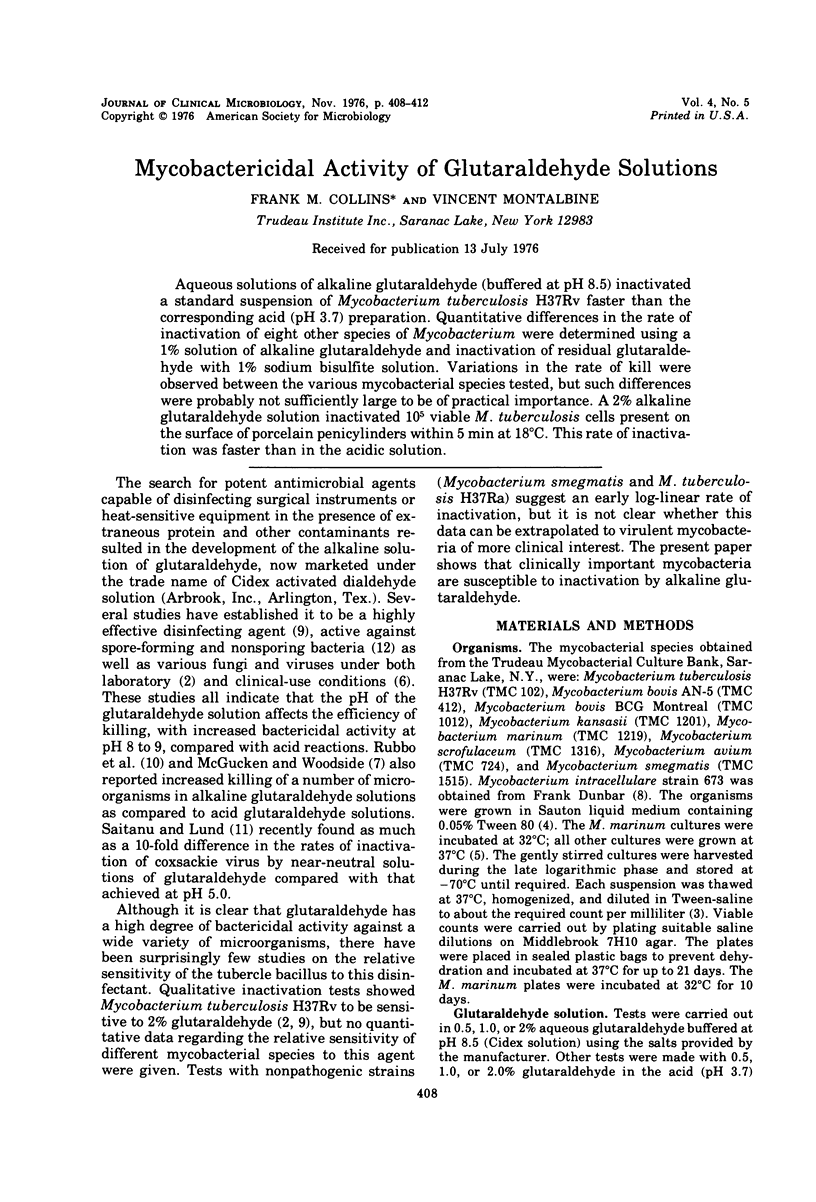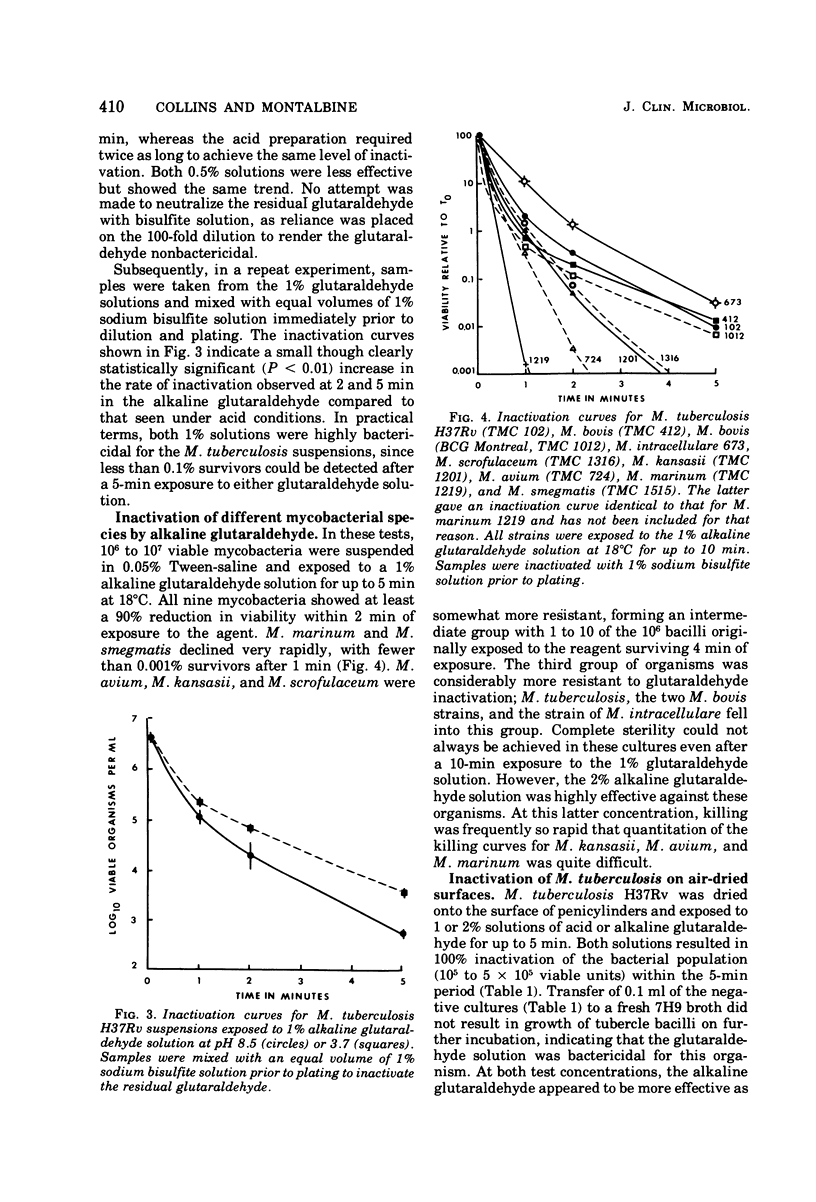Abstract
Aqueous solutions of alkaline glutaraldehyde (buffered at pH 8.5) inactivated a standard suspension of Mycobacterium tuberculosis H37Rv faster than the corresponding acid (pH 3.7 preparation. Quantitative differences in the rate of inactivation of eight other species of Mycobacterium were determined using a 1% solution of alkaline glutaraldehyde and inactivation of residual glutaraldehyde with 1% sodium bisulfite solution. Variations in the rate of kill were observed between the various mycobacterial species tested, but such differences were probably not sufficiently large to be of practical importance. A 2% alkaline glutaraldehyde solution inactivated 10(5) viable M. tuberculosis cells present on the surface of porcelain penicylinders within 5 min at 18 degrees C. This rate of inactivation was faster than in the acidic solution.
Full text
PDF




Selected References
These references are in PubMed. This may not be the complete list of references from this article.
- BORICK P. M., DONDERSHINE F. H., CHANDLER V. L. ALKALINIZED GLUTARALDEHYDE, A NEW ANTIMICROBIAL AGENT. J Pharm Sci. 1964 Oct;53:1273–1275. doi: 10.1002/jps.2600531041. [DOI] [PubMed] [Google Scholar]
- Borick P. M. Chemical sterilizers (chemosterilizers). Adv Appl Microbiol. 1968;10:291–312. doi: 10.1016/s0065-2164(08)70195-3. [DOI] [PubMed] [Google Scholar]
- Collins F. M., Mackaness G. B. The relationship of delayed hypersensitivity to acquired antituberculous immunity. I. Tuberculin sensitivity and resistance to reinfection in BCG-vaccinated mice. Cell Immunol. 1970 Sep;1(3):253–265. doi: 10.1016/0008-8749(70)90047-x. [DOI] [PubMed] [Google Scholar]
- Collins F. M., Montalbine V., Morrison N. E. Growth and immunogenicity of photochromogenic strains of mycobacteria in the footpads of normal mice. Infect Immun. 1975 May;11(5):1079–1087. doi: 10.1128/iai.11.5.1079-1087.1975. [DOI] [PMC free article] [PubMed] [Google Scholar]
- Collins F. M., Wayne L. G., v Montalbine The effect of cultural conditions on the distribution of Mycobacterium tuberculosis in the spleens and lungs of specific pathogen-free mice. Am Rev Respir Dis. 1974 Aug;110(2):147–156. doi: 10.1164/arrd.1974.110.2.147. [DOI] [PubMed] [Google Scholar]
- Haselhuhn D. H., Brason F. W., Borick P. M. "In use" study of buffered glutaraldehyde for cold sterilization of anesthesia equipment. Anesth Analg. 1967 Jul-Aug;46(4):468–474. [PubMed] [Google Scholar]
- McGucken P. V., Woodside W. Studies on the mode of action of glutaraldehyde on Escherichia coli. J Appl Bacteriol. 1973 Sep;36(3):419–426. doi: 10.1111/j.1365-2672.1973.tb04123.x. [DOI] [PubMed] [Google Scholar]
- Pejovic I., Dunbar F. P., Cacciatore R., Valdez H., Sanders E. Immunity to Mycobacterium tuberculosis in mice. Effect of heterologous mycobacteria in relation to quantitative and qualitative differences in their organ localization. Am Rev Respir Dis. 1969 May;99(5):786–789. doi: 10.1164/arrd.1969.99.5.786. [DOI] [PubMed] [Google Scholar]
- Rubbo S. D., Gardner J. F., Webb R. L. Biocidal activities of glutaraldehyde and related compounds. J Appl Bacteriol. 1967 Apr;30(1):78–87. doi: 10.1111/j.1365-2672.1967.tb00277.x. [DOI] [PubMed] [Google Scholar]
- Saitanu K., Lund E. Inactivation of enterovirus by glutaraldehyde. Appl Microbiol. 1975 May;29(5):571–574. doi: 10.1128/am.29.5.571-574.1975. [DOI] [PMC free article] [PubMed] [Google Scholar]


